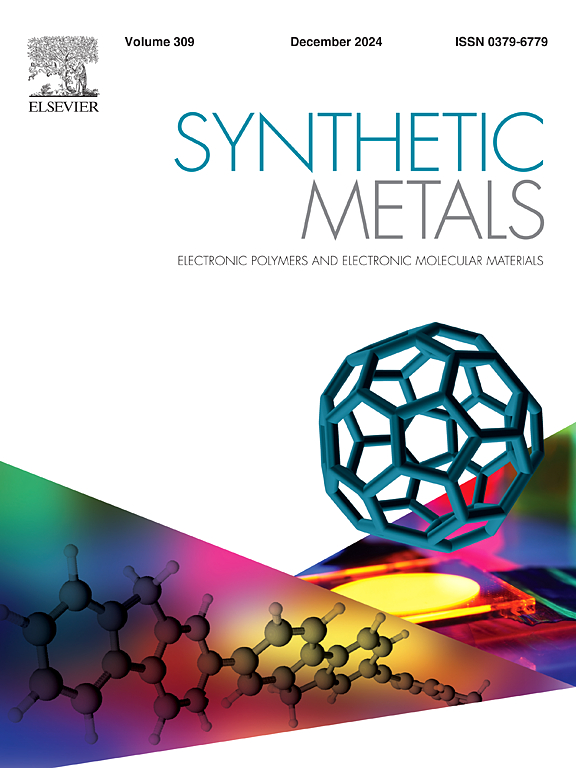Research on the protection of black phosphorus (BP) by the monolayer 7,7,8,8-tetracyanoquinodimethane (TCNQ)
IF 4.6
3区 材料科学
Q2 MATERIALS SCIENCE, MULTIDISCIPLINARY
引用次数: 0
Abstract
Black phosphorus (BP) has attracted widespread attention in multiple research fields due to its excellent optoelectronic properties, such as adjustable direct bandgap, optical and electrical anisotropy. However, the poor air stability of BP limits its practical application. To protect BP through physical isolation and chemical passivation, a strong n-type organic semiconductor, 7,7,8,8-tetracyanoquinodimethane (TCNQ) was deposited on BP. The protective effect and the underlying mechanisms have been comprehensively investigated through various interface characterization techniques and density functional theory (DFT) calculations. It is found that the high adsorption energy (AE) between TCNQ and BP leads to the desorption of TCNQ from BP surface and TCNQ forms a dense monolayer (ML) film on BP in a stable lying configuration, which can protect BP from air exposure to some extent. Due to the higher work function (WF) of TCNQ compared to BP, the electron of BP at the interface are transferred to TCNQ through the quinone ring, resulting in a redistribution of electrons near the quinone ring of TCNQ and a shift of the C 1 s peak as well as the Raman peaks of C-C and C-C-H. The electron transfer from BP to TCNQ not only leads to an upward bending of the conduction band (CB) of BP at the interface, increasing the electron transfer barrier (ETB) between BP and O2, but also depletes the lone pair electrons of BP at the interface, protecting the shallow layer BP from oxidation and degradation. The ML of TCNQ and the shallow layer of BP significantly delays the contact between inner layer of BP and air, prolonging the stability of BP in air for more than 10 days. In addition, it is also confirmed that ML TCNQ has the minimal impact on the intrinsic structure and properties of BP. This work provides a new strategy for the protection and application of BP.
单层7,7,8,8-四氰喹诺二甲烷(TCNQ)对黑磷(BP)的保护作用研究
黑磷具有直接带隙可调、光电各向异性等优异的光电特性,在多个研究领域受到广泛关注。但BP的空气稳定性差,限制了其实际应用。为了通过物理隔离和化学钝化保护BP,在BP表面沉积了强n型有机半导体7,7,8,8-四氰喹啉二甲烷(TCNQ)。通过各种界面表征技术和密度泛函理论(DFT)计算,全面研究了保护作用及其潜在机制。发现TCNQ与BP之间的高吸附能(AE)导致TCNQ从BP表面脱附,TCNQ在BP表面形成致密的单层(ML)膜,呈稳定的躺置构型,在一定程度上保护BP免受空气暴露。由于TCNQ比BP具有更高的功函数(WF),界面处BP的电子通过醌环转移到TCNQ上,导致TCNQ醌环附近电子重新分布,C-C和C-C- h的c1 s峰以及拉曼峰发生移位。从BP到TCNQ的电子转移不仅导致BP在界面处的导带(CB)向上弯曲,增加了BP与O2之间的电子转移势垒(ETB),而且使BP在界面处的孤对电子耗尽,保护了BP浅层不被氧化和降解。TCNQ的ML和BP的浅层明显延迟了BP内层与空气的接触,使BP在空气中的稳定性延长了10天以上。此外,还证实了ML TCNQ对BP固有结构和性质的影响最小。本研究为BP的保护和利用提供了新的策略。
本文章由计算机程序翻译,如有差异,请以英文原文为准。
求助全文
约1分钟内获得全文
求助全文
来源期刊

Synthetic Metals
工程技术-材料科学:综合
CiteScore
8.30
自引率
4.50%
发文量
189
审稿时长
33 days
期刊介绍:
This journal is an international medium for the rapid publication of original research papers, short communications and subject reviews dealing with research on and applications of electronic polymers and electronic molecular materials including novel carbon architectures. These functional materials have the properties of metals, semiconductors or magnets and are distinguishable from elemental and alloy/binary metals, semiconductors and magnets.
 求助内容:
求助内容: 应助结果提醒方式:
应助结果提醒方式:


